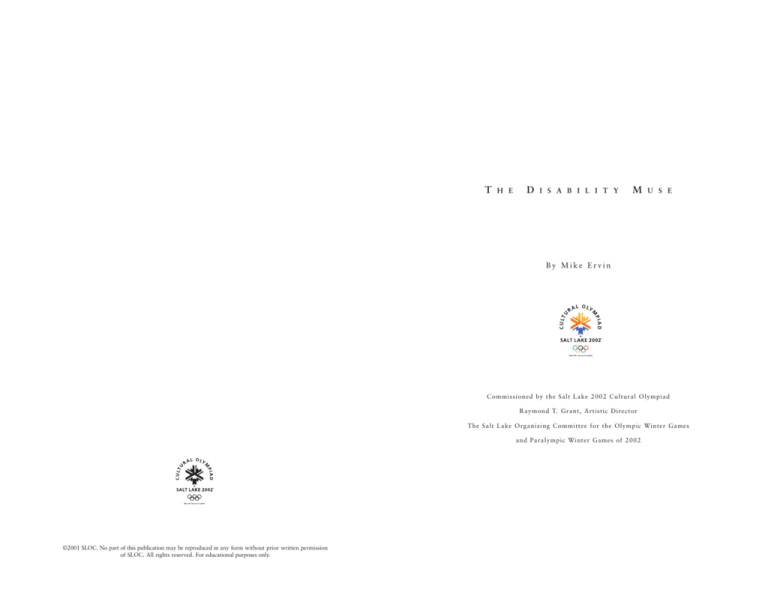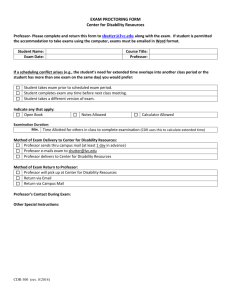
T
H E
D
I S A B I L I T Y
M
U S E
By Mike Ervin
Commissioned by the Salt Lake 2002 Cultural Olympiad
Raymond T. Grant, Artistic Director
The Salt Lake Organizing Committee for the Olympic Winter Games
and Paralympic Winter Games of 2002
©2001 SLOC. No part of this publication may be reproduced in any form without prior written permission
of SLOC. All rights reserved. For educational purposes only.
true test is whether others who have lived the disability life find something
I
in my writing that bounces back a reflection. All I can do is take care of
Bowling is loaded with disability themes. The main character is a cocky,
that and hope for the best with everyone else.
30-ish quad riding high on a wave of recently discovered disability pride.
The recognition of the nondisabled world is not the ultimate stamp of artistic legitimacy. Naturally, every artist wants as many people as possible to be
moved by his or her message. Better millions than thousands. But for me the
sent a copy of my play, “The History of Bowling,” to a writer friend
whose literary opinion I greatly respect. He is published regularly in
a famous magazine. He’s written novels, short stories, the works.
He falls into a rocky romance with a young, brainy woman with epilepsy
Cheryl says she’s found that billing herself in bold bright letters as an
who is still deep in the disability closet. And then there is the deaf and blind
artist with a disability bent also has opened up more, not fewer, gigs.
guy, who is equally proficient at hustling poker opponents and women.
Trying to pretend she could compete with the Julia Roberts types on their
home field would be beating her head against the wall, she says. “I’m
My friend gave me a lot of good advice. But the piece of advice I remember
waaaaaaaaay too different looking to be picked up by the mainstream.
most is the one I resolved immediately not to take. “Now you should write
Not in this lifetime.”
something that doesn’t have anything to do with disability,” he said, “so
you can show your range.”
Having said all that, CMW has no trouble deciding whether she would
rather perform during the Olympics or the Paralympics. “The Olympics.
As a playwright, fiction writer and journalist, I write almost exclusively
More crips watch them than the Para Games and here in the States the
about the rich humor inherent in being a modern-day American with a
Para Games are presented not as sports but as human interest. I’d always
disability. For me it is an endless reservoir full of universal themes and
rather have a large audience and a gig backed by mega bucks. As a crip
conflicts. I have just begun to splash around in it. Why stop now?
it ain’t likely to happen any time soon.”
I believe every artist with a disability who sticks it out long enough goes
I suppose if I was under oath here I would have to say I would make the
through an identity crisis. How often and how directly should our work
same choice. The draw of the Olympic Games presents an opportunity for
address our reality of living with a disability? This internal debate plays itself
exposure that may never come again. But if I ended up being slotted in the
out at the 2002 Cultural Olympiad as artists with disabilities contemplate
Paralympics with a more cozy crowd, I would probably have more fun.
the scope, content and audience of their work. Should one identify as an
artist with a disability? Is it better for one’s work to be seen by a broader,
general audience during the Olympics or by a more intimate, and presumably
Mike Ervin is a disability rights activist, playwright and journalist.
more receptive audience, during the Paralympics?
He currently works in Chicago.
Back when I was trying to avoid any and all subject matter that might result
in my being characterized as an artist with a disability, I was driven by an
impulse not to be seen as limited. I finally gave up because such strenuous
avoidance was too much work.
4
1
The enduring power of art is in its ability to get down to the truth. For me,
about and that was disability and childhood sexual abuse,” she says. “I fig-
writing about living on something resembling your own terms in a world
ured if I had to live these realities, I sure as hell wasn’t going to write about
full of sugarcoated disability bigotry is loaded with endless, painfully comic
them. Writing was supposed to take me somewhere else.”
truth. To avoid it was to defeat the purpose of being an artist. To avoid it
in the name of achieving universality was particularly futile. Art becomes
She also feared, as I did, that concentrating on disability themes would limit
universal when it strikes the root of the truth with resonance. You can’t do
her artistic range and performance opportunities as well as her potential
that through homogenization. The dishonesty will soon show.
audiences.
Let me bring in my old buddy Cheryl Marie Wade to help me out here.
“I found just the opposite to be true,” she says. “The more specific I
Cheryl gets around in a motorized wheelchair and lives in the San
became in my work, the more powerful and universal it became. I had
Francisco Bay area. She is an incredible writer, video maker and performer.
a lot more to say when I blew the cork out about writing from my own
Her most recent video, “Disability Culture Rap,” won the Best of Festival
identity/experience.”
award at last year’s Superfest, the annual disability film festival. Coming
soon is her new poetry performance video, “Body Talk.”
As for audiences, I think they deserve more credit for perceptiveness. Sure,
there will always be some who will dismiss art exploring disability without
I consider CMW to be the artist who has provided the most momentum and
giving it a chance as depressing or maudlin or whatever the stereotype du
definition to the disability culture movement. Back when I was still groping
jour. But most people who spend time and money indulging in the arts are
in the dark for a style and voice, she was directing and performing for WRY
looking for honest perspective. If we do our job as artists, the rapport
CRIPS, a disabled women’s theatre group that put on shows with names like
should take care of itself.
“The Miss Normal Pageant.”
CMW says, “You never know what it is that makes the connection, so the
Cheryl was the first performer doing work with a disability culture theme
only thing you can do is be true to your own vision and voice and passion.
to receive an NEA Solo Theatre Artist’s Fellowship. Her poetry is stark,
Because I write about transformation and very deeply about the body, any-
satirical, tender and bold. She is not afraid to make her crippled up self
one who’s willing to open themselves up to my work can get something out
into a mocking boogeyman who shoves the pain and frustration and pride
of it. I don’t understand everything in Tennessee Williams because I’m not
and joy of her disability reality in your face. When she performs the poem
Southern, but it doesn’t prevent me from being enthralled. If we write some-
Gimp Hands in her video entitled “HERE,” she waggles her gnarled,
thing with great poetry and a large emotional landscape, why shouldn’t abs
arthritic hands in front of her face and says, “Mine are the hands of your
be willing to come along for the ride?”
bad dreams...Booga Booga.”
Even after our best efforts, our message still may not compute on a larger
Cheryl wrings art from the disability experience so relentlessly that it’s hard
scale. But if our most loyal audience turns out to be other people with dis-
to believe that she, too, once did contortions to avoid being identified as an
abilities, there’s nothing wrong with that. Cheryl says such audiences
artist with a disability. “I swore there were two subjects I’d never write
bring out her best work. “I think it’s very hard to express fully and take
big risks if you’re the only crip in a room full of abs.”
2
3








